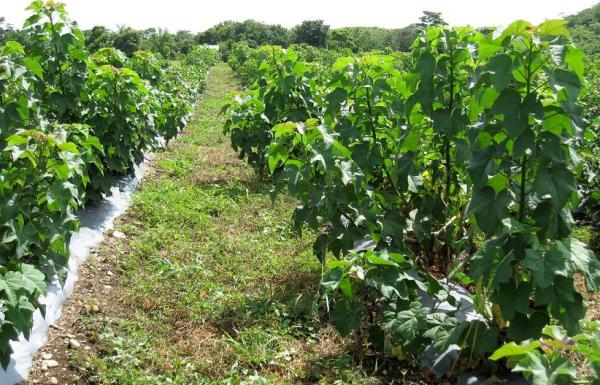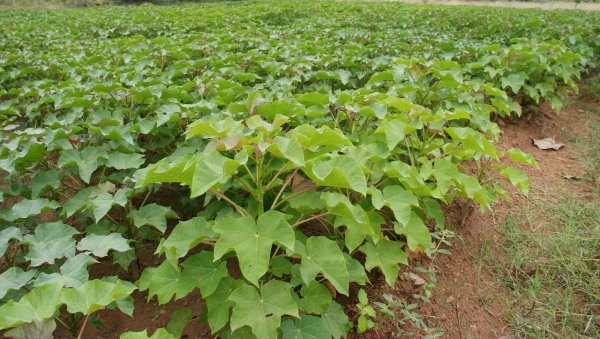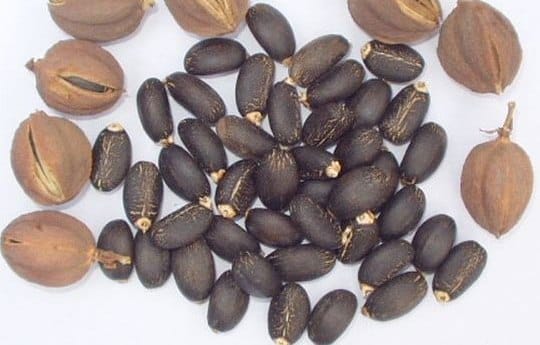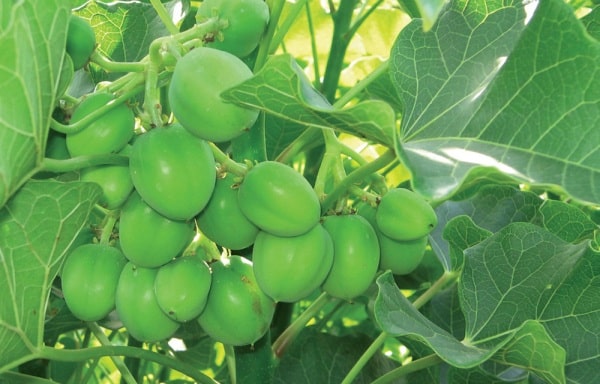Jatropha Cultivation Guide:

Introduction
Jatropha curcas is one of the best oilseed plants and identified as the most suitable oil seed-bearing plant due to its various favorable attributes. Jatropha is a deciduous large shrub or small tree that can reach up to 5 meters in height with smooth gray bark. Jatropha plants are native to Central America and well-adapted to the tropics and subtropics of the world. Jatropha is a hardy plant and it has a short gestation period when compared to other oilseed crops. The other advantage of the plant is it has wider adaptability of different climatic conditions and can be grown in most of the areas. The other reason to go for the cultivation of Jatropha is; it produces high-quality oil and oil recovery is very high. Cultivation of Jatropha appears viable due to its demand. Basically, Jatropha crop meant for wastelands and less productive lands, hence this crop will not replace other important food crops grown in rich soils. Jatropha plants produce oilseeds as a source of energy in the form of bio-diesel. Jatropha plants belong to the family of “Euphorbiaceae” and genus of “Jatropha L.”. As with many members of the family Euphorbiaceae, Jatropha contains compounds that are highly toxic. Jatropha farming is profitable as there is a huge demand for mass production of seeds for bio-diesel. In India, Jatropha is grown in almost all the state as a live fence for protection of agricultural crops from being damaged by cattle or goat or sheep as these animals do not eat Jatropha plants.
Advantages of Jatropha Crop
The following are some of the Jatropha plantation advantages.
- Jatropha crop can be grown in a wide range of soil including wastelands, poor soils, low rainfall, and drought areas.
- Jatropha plants are hardy and can tolerate water scarcity.
- Wastelands and other lands not suitable for crops can be utilized for growing Jatropha seeds.
- Jatropha cultivation boosts rural economy by providing local employment.
- Jatropha plantation prevents soil erosion.
- Jatropha crop will not compete with any other crop and supplements the profits.
- Wasteland soil fertility can be increased through Jatropha plantation.
- A Jatropha plant possesses medicinal as well as other industrial uses.
- Jatropha plants will generate returns for 30 years.
- On an average one can get 10 to 15,000 Rupees per 1-acre plantation from the 4th year.
Note: The only disadvantage of these plants is that they cannot be grown in flooding and waterlogged areas.
Read: How to Test for Seed Viability.
Scope of Jatropha Farming
Growing Jatropha is viable due to its high demand and it does not replace traditional crops. As Indian states have many barren lands where annual rainfall is less, this crop is the best hope for farmers in that area. Apart from this, Jatropha can be grown as live fencing for other agricultural crops as livestock will not eat these plants. When it comes to using Jatropha, all parts of the shrub can be used as input to traditional medicine as well as raw material for pharmaceutical and cosmetic industries. The commercial cultivation of Jatropha in poor soils, barren lands and drought areas could provide regular employment and could improve their economic life. Farmers can use bio-diesel for operating oil engines for pumping water and operating small machinery for other purposes.

Jatropha Varieties (Cultivars)
There is no recommended variety. The female: male ratio of the flower which indicative of productivity is observed to be 1:12 compared to 1:16 to 1: 20 found in other Indian states. The plantation can be started with locally available one. Find out with agriculture/forest department for improved varieties.
Local Names of Jatropha in India
Jatropha is called by more than 200 different names in different countries. Common names of Jatropha are; Purging tree, Curcas Nut, Physic Nut and in Hindi, it is called as Ratanjyot.
Climate and Soil Requirement for Jatropha Cultivation
Basically, Jatropha is a tropical plant and thrives well in sub-tropics. This crop does not tolerate waterlogging and frost conditions. This can be cultivated in all most all soils having a pH range of 5.4 to 8.4. The main advantage of these crops is, it can be grown even in poorest stony soils, cracks of the rocks. Avoid soils where flooding is possible. This does not require much water and will come up in low rainfall areas as well. It does not require any land /soil preparation (tillage) for planting.
Propagation, Seed Rate, Planting and Spacing in Jatropha Cultivation
Jatropha plants are propagated through seeds and stem cuttings. If the crop is planned for commercial purpose, seed propagation is recommended. Selecting quality seeds for germination is an important factor for achieving desired yields. Good quality plump seeds should be selected for sowing in the field. Seeds should be treated (soaked) in the cow-dung solution for 10 to 12 hours and kept under the wet gunny bags for 10 to 12 hours. This crop requires a hot and humid climate for sowing as this results in good germination of seeds. Usually, germinated seeds are sown in poly bags of 15 cm x 25 cm size filled with soil, sand and well-decomposed farmyard manure (FMY) in the ratio of 1:1:1 respectively. Actually, seeds or stem cuttings can be sown directly in the main field. However, pre-rooted cuttings in poly bags and then transplanted in the main field proved to be giving better results.

Seed rate depends on variety, on an average, 6 to 7 kg of seed will cover 1-hectare land. Generally, the fruiting period takes linger in the crop propagated by seeds when compared to the crop propagated by stem cuttings.
The land should be prepared by giving 2 or 3 ploughings depending upon soil type. In the direct planting system, the seed/stem-cuttings should be planted in the main field with the onset of monsoon at a recommended spacing of 3-meter x 2 meters. In the case of regions where ploughing is not possible, pits of 30 cm x 30 cm x 30 cm should be dug at the recommended spacing. These pits should be re-filled with topsoil and organic manures of 500 grams farmyard manure(FYM) and 100 grams of neem cake or Jatropha oil cake and 100 grams of superphosphate. Lesser spacing is preferred if the plants are grown as a hedgerow, for a fence, or for soil conserving purposes. Actual spacing will be based, soil quality/condition, humidity, rainfall, intercropping.
Read: Soil Sterilization Methods.
Irrigation in Jatropha Cultivation
These plants don’t require much irrigation and will survive in minimal rainfall areas. These plants do not require supplementary irrigation if planted in the onset of monsoon. Natural mulch (fallen leaves) provides needed soil moisture.
Manures and Fertilizers in Jatropha Cultivation
Two kg of compost should be added for each pit during planting time. Subsequently, depending on soil type and fertility, 4 to 5 kg of farmyard manure (FMY)along with N:P:K should be applied near the crown following ring method just before the onset of monsoon. Application of superphosphate at the rate of 125 kg/ha and alternate with one dose of 20: 120:60 kg N:P:K/year from the second year improves yield. From fourth year onwards, 125 kg superphosphate should be added to the above-mentioned dose.
Intercultural Operations in Jatropha Cultivation
Two weedings can be carried out during its growth period. It does not require any supplementary irrigation if the crop is planted during monsoon season. Fallen leaves around the roots will act as good mulch material and finally will convert into organic matter which will be helpful in increasing the soil fertility. Carry out light harrowing during the early growth stage. To induce laterals, pinching terminals at 6 months age is essential. For early flowering, apply GA @ 100-PPM spray.
When it comes to pruning and trimming, Jatropha plants should be trimmed during spring season up to 4 years to give a bushy type shape. In order to induce secondary branches on the plant, the terminal growing twig should be pinched. Similar way, the secondary and tertiary branches should be pinched or pruned at the end of the first year to induce a minimum of 20 to 25 branches at the end of the second year. Once in 10 years, the Jatropha plant should be cut leaving 1 feet height from ground level for rejuvenation.
Intercropping in Jatropha Cultivation
Farmers can get some extra income with intercropping in Jatropha cultivation. Mostly shade loving and short duration crops are suitable for inter-cropping. Short duration grain and vegetable crops like, green gram, black gram, and pumpkin, ash gourd, cucumber, tomato, green chilli, bitter gourd, ash gourd can be grown as intercrops during initial 2 years period. Any shade loving herbal/aroma plants like Patchouli, Vanilla can be grown as intercrops in Jatropha cultivation which could result in more profits.
Pests and Diseases in Jatropha Cultivation
Jatropha crop is not affected by many pests and diseases. However, Collar rot may be the problem at the beginning of its growth. This can be controlled by the application of 1 % Bordeaux mixture drenching.
Read: Feed Conversion Ratio in Livestock.
Note: Contact your local agriculture department or university for pests and disease symptoms and their control. They are the best source for pest control solutions in Jatropha cultivation.
Harvest in Jatropha Cultivation
Generally, Jatropha trees start producing flowers after 9 to 12 months of sowing. Usually, flowers are induced in the rainy season and bear fruits and mature in winter. Pods should be collected when they turn into a yellow color and dried. The flowering would be early in sunny conditions whereas it is less in shady conditions. If the crop is propagated by stem cuttings, they come to flowering after 6 months of the plantation which is earlier than the crop propagated through seeds. The actual economic yield starts from the end of the third year. Seeds can be separated from collected dried pods either manually or with a machine. Allow seeds to dry for 5 to 6 days to reduce moisture level before going for packing.

Yield in Jatropha Cultivation
Factors that influence the crop yield are soil fertility, climatic conditions, irrigation, cultivation methods, and farm management practices. On average, 3 to 6.5 kg per plant or 6500 to 7000 kg/ha can be expected from the end of the 6th year of plantation. Actually, Jatropha trees start yielding after second year planting. However, yield at this stage is low like 0.5 to 1 kg per plant. The economic life of the Jatropha tree is 30-40 years. However, it survives till 50 years if the root system does not contact with the rising water table in ground.
Marketing of Jatropha:
Contact local oilseed companies or any medicinal/herbal/pharmaceutical companies for better marketing prospects.
Final Note of Jatropha Cultivation:
Some countries have banned this crop, find out with your local agriculture/forestry department for more details.
Read: Miniature Gardening Techniques and Ideas.
I want to commence with Jatropha cultivation at a large scale and wish to find out about its economic viability.
Please provide me with a suitable contact address to get in touch with you guys. I have been trying to get in touch with you guys for 2 months but have found no luck. (I don’t mind paying a consulting fee if we decide to move forward).
I am interested in cultivating Jatropha. I would like to gather more details. Please let me know if you can guide me. Thanks
Dear Smit and Jain,
We, JatroSolutions GmbH from Stuttgart (Germany), can provide you with consultancy service in any matter related to jatropha (agronomy, post-harvest, processing, marketing etc.), we offer high-quality seeds of elite cultivars we developed in our intensive breeding program and also, we offer site visits to evaluate your individual case for optimal consultancy or cooperation. Please feel free to contact my colleague Brigitte Bohlinger (brigitte.bohlinger@jatrosolutions.com), we are happy to enlarge the “jatropha community” and looking forward to get in touch with you. Our aim is to prevent any failure of jatropha projects as it happened in the past due to many false statements or malinterpretation of field tests. We want to promote and develop jatropha as a field crop due to its multiple benefits. Looking forward to hear from you!
Kind regards, Elisa Senger
Hi
Am interested in buying jathropa green fruit, v r in export’s
Please b in touch
Is there any buyers for jatropha seeds…??? Please contact or whatsapp on 8983888484
Namaste… I am planning to start Jatropha farming in the Northern region of India, Haryana. I would like to get in touch with the expert who could guide me in all possible ways to educate about and monetize from this crop.
Thank you Sir for the information related to Jatropha, i am planning to work on Jatropha for bioremediation of crude oil.
Thanks for the info, I am interested to start planting jatropha in SA for business
I would like to draw your kind attention please be inform me how to do DPR